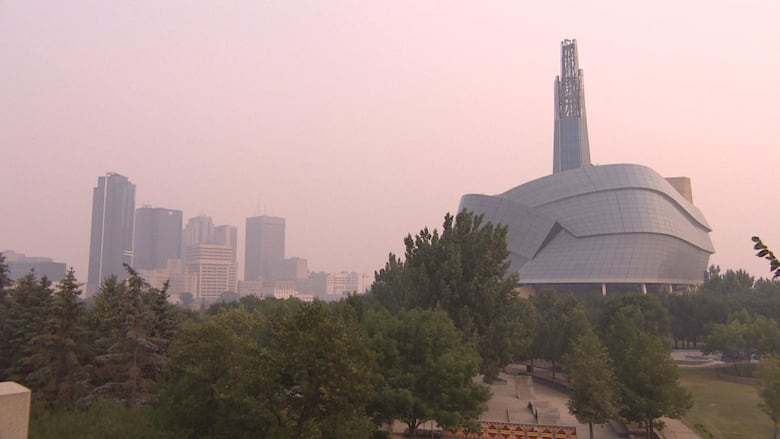Winnipeg air quality among worst on planet due to wildfires, prompting warnings
'Once you get to 10-plus [air quality rating], numbers kind of lose meaning,' says respiratory researcher

The sky over Winnipeg isn't just among the smokiest in Canada right now — the city has the unenviable distinction of having one of the worst air quality ratings in the world due to wildfires, beating out the likes of huge metropolitan areas such as New Delhi, India, Beijing, China, and Toronto.
According to a global ranking by IQAir, a Swiss air quality technology company, Winnipeg had a rating of 166 as of 10 a.m. Friday morning, compared to 97 in Toronto, 58 in Beijing, and 107 in New Delhi.
"The air quality we're definitely seeing [in] our area, in comparison to the rest of Canada, is definitely the worst right now," Keane Kokolsky, meteorologist with Environment and Climate Change Canada, told CBC News on Friday morning.
"With all the smoke that's already still basically hovering around the area in the Prairies right now it's really just kind of lingering there and with more smoke being brought into the atmosphere by these fires it's really just going to continue to add to the situation."
Environment and Climate Change Canada's monitoring sites pegged the air quality index values at 10 or higher across Manitoba on Friday, with pockets of northern Saskatchewan and northern Ontario experiencing even worse air quality than Winnipeg.
Kokolsky said an air quality warning remains in effect in Manitoba and people should limit time outdoors.
Though the air quality will improve slightly in the next couple of days, Kokolsky said it will be short-lived. Expect hazy skies to return on Sunday, he said.
Manitoba is in the grips of its worst wildfire season in three decades.
This week, Winnipeg broke its own record for smokiest summer ever, surpassing a previous record set in 1961.
Friday is the second day in a row Winnipeg was sitting at 10 or higher on Environment and Climate Change Canada's air quality index — but it may be even worse than what's reflected by that measurement.
"Once you get to 10-plus, numbers kind of lose meaning," said Chris Pascoe, associate professor at University of Manitoba in the department of physiology and pathophysiology.
Pascoe said much of Thursday saw levels in the 10-plus range, which is considered unhealthy for everybody — not just for groups at-risk.
"It seemed to get a little better last night and then kind of throughout the night it kind of rolled in with even more ferocity than we've seen before, with levels peaking much higher than even 10-plus, well above our scale would even go," said Pascoe, who is also a respiratory health research scientist at the Children's Hospital Research Institute of Manitoba.

Pascoe said the amount of particulate matter in the air can continue to increase beyond what's reflected in that unhealthy level 10-plus rating.
'Equivalent of 3 to 4 cigarettes'
Typically once levels reach 60 to 70 micrograms per-metre-cubed of particulate in the air — a mass of fine particles in the air — public safety becomes a concern, said Pascoe.
He said on Thursday, between 11 p.m. and midnight, levels reached 250 to 260, or as much as 280, micrograms.
"Being outside for an hour in that smoke was equivalent to smoking three to four cigarettes. It was quite problematic," he said.
"I think people are starting to appreciate how harmful this is. Unfortunately, it's taken a couple summers in a row of wildfire smoke like this in Canada to hammer home the point that this is a big health burden that needs to be addressed."
Pascoe said there are increased cases not just of respiratory-related issues but heart attack and stroke after acute air quality events.
He said there is ongoing research looking into whether people who live or work nearer to wildfire smoke sources are experiencing more health issues.
"I would imagine in the coming years when the research is completed [we could see] that there was an uptick in hospitalizations this summer for respiratory conditions and cardiovascular conditions," said Pascoe.
He said there is research emerging globally from 2023 that suggests an increase in hospitalizations occurred anywhere from one day to a week after acute wildfire smoke exposure that year, he said.
"This feels like this is going to be the norm for most of Canada and North America for years to come as climate change starts to make drought conditions worse," he said.
"It's been a really bad summer for wildfire smoke and you kind of start to worry about these long-time exposures where people who have to be outside for of a job, or individuals who are experiencing homelessness ... are exposed to these under chronic conditions."
Pascoe said when air quality is as bad as it has been it's important to stay indoors, keep your windows closed, and minimize exposure through the use of air filtration or purifier systems in the home. Wearing a proper mask, such as a well-fitted N95 or respirator, can help filter out air-borne particles.
"We can kind of shelter inside, we can minimize that risk, but the summer we've been having, we're now talking about cumulative and chronic exposure."
More from CBC Manitoba:
With files from Josh Crabb and Erin Brohman

